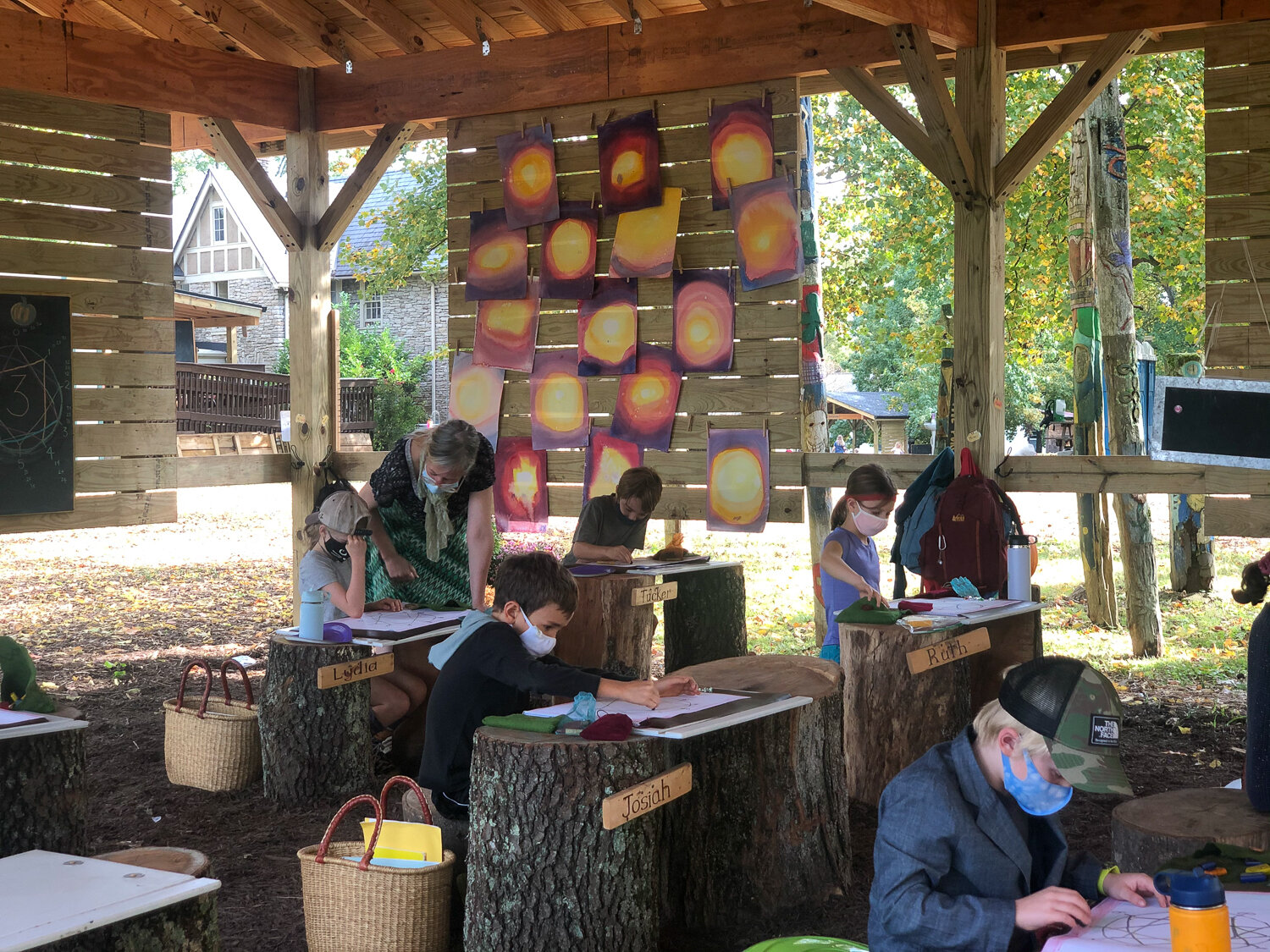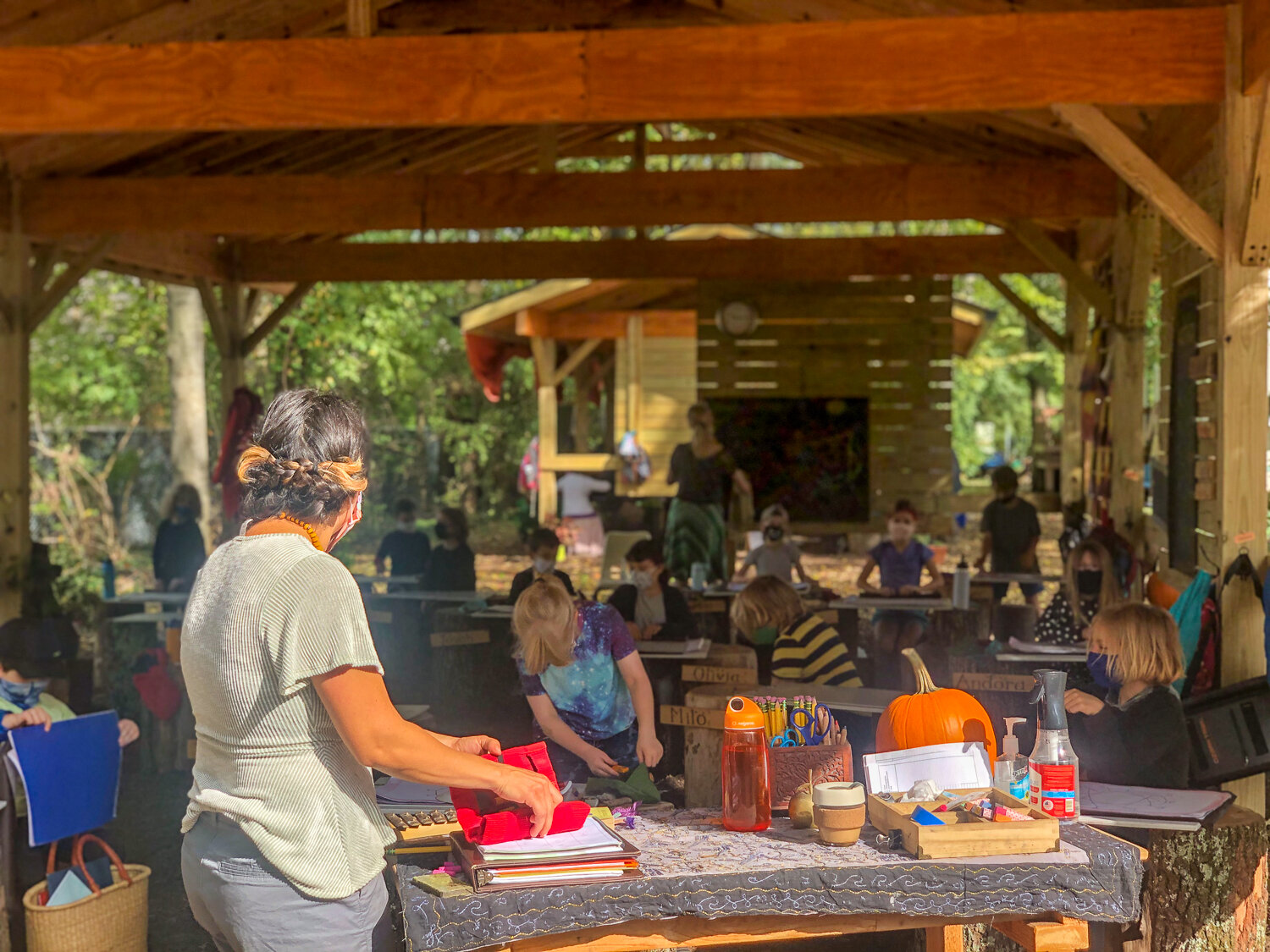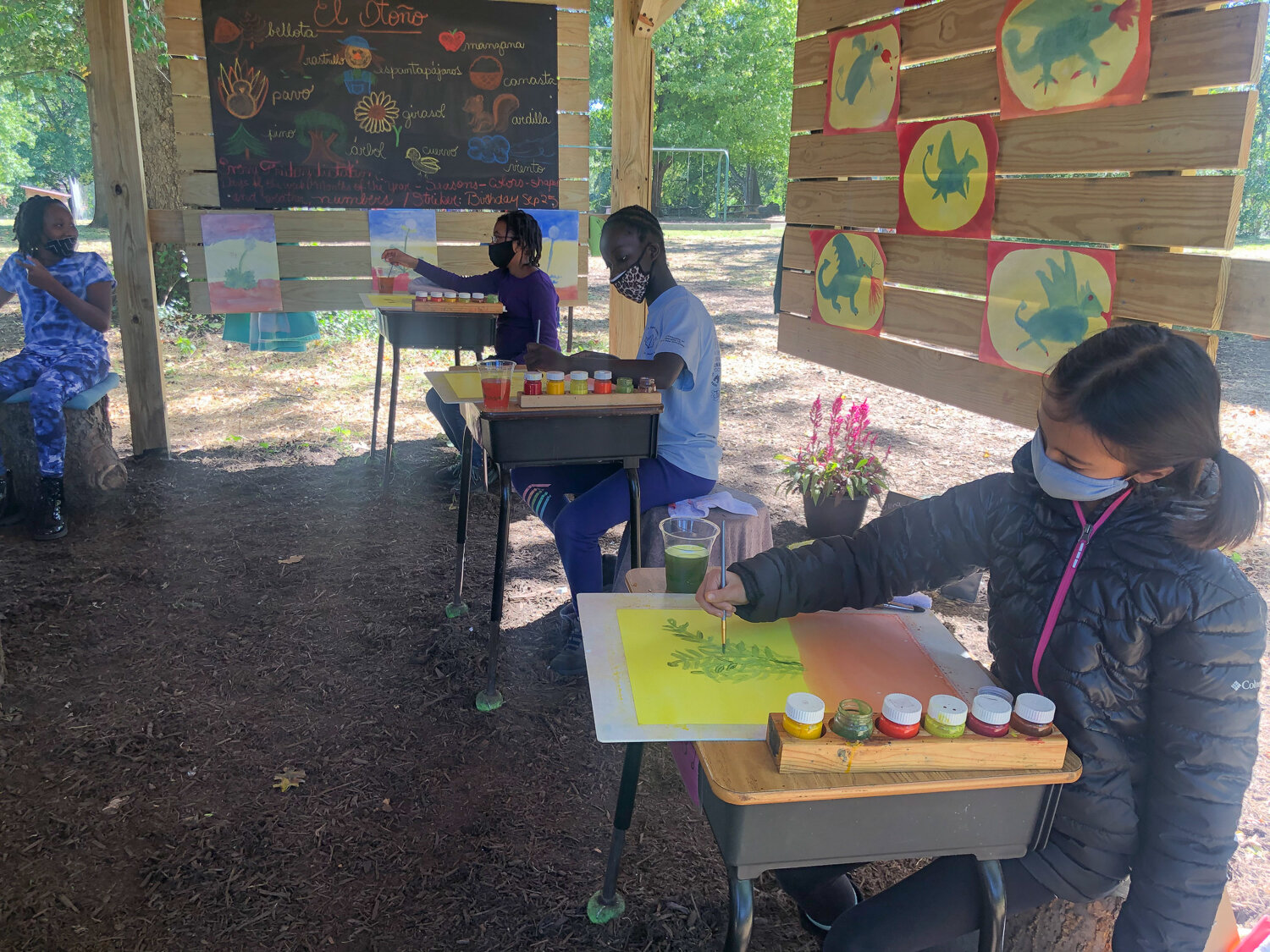Linden Waldorf School
Nashville, Tennessee
Linden Waldorf School is an independent school in Nashville Tennessee, nestled on 12.6 acres of wooded land and green space that allow students to experience the natural world every day. The school serves ~200 children, in grades K-8, and includes 29 staff members.
In July 2020, the school decided to address COVID-19 by aiming to bring its school program outside as much as possible for the 2020-21 school year. They succeeded in building their outdoor classrooms before school started in September.
As a Waldorf School, their academic program and philosophy are well aligned with outdoor learning. In previous years, students spent approximately 30% of each day outdoors. With their new outdoor classroom spaces built in 2020 to address the COVID pandemic, 100% of the students are now spending approximately 95% of each school day outdoors. Their new outdoor spaces are much-loved by the school community and have allowed them to operate a full time, in-person learning program for the whole fall semester—without spreading the virus.
“We are so happy that we went full bore with our outdoor classrooms, because we’re the only school in town that I know of that has not had a single case.”
School Education Data
Independent school
~200 students, K - 8th grade
29 staff members
12.6 acres of school grounds
New facilities: 9 outdoor classrooms that each accommodate 8-19 students (120 student total capacity)
Pre-COVID: 100% of students outside for 30% of the day
During COVID: 100% of students outside for 95% of the day
Location
Nashville, Tennessee — semi-urban setting
Climate
Warm, humid spring and fall weather: Daytime temperatures 48°F - 83°F
Cold, wet winters: Average temperatures range from 31°F - 48°F from the end of November through the end of February
Precipitation: 119 days per year
Rainfall: 49” per year
Snowfall: 4” per year
Green Schoolyards America’s founder, Sharon Danks, spoke with Linden Waldorf School’s Head of School, Tricia Drake, in November 2020 about the school’s experience with outdoor learning this fall:
Q: How did your school use outdoor spaces before the pandemic?
TD: “Pre-COVID, we were already outside, twice a day, rain or shine, year round, for four recesses in every grade level all the way through eighth grade. So, it was sort of an easy transition for us to take learning outside this year because we already had a significant chunk of time outside that was a core part of our curriculum. Our usual curriculum already uses the outdoors to teach: a geology block, astronomy, botany, orienteering, gardening, and the herb gardening class. I’d say the students easily spent 30% of their time outside before COVID.”
Q: How did your school decide to bring education outside this year?
TD: “You know, I’d say it was you. I had just been doing some research and kept coming across your name. Then, by mid-July—before I went to any of the board members or any of the faculty—I first talked to a parent whom I knew was an architect and asked him, “Is this too crazy? Can you even design us something?” And he said, “you know, school starts in five weeks.” And I said, “Yeah, but that’s plenty of time.” We did some research and then just started making our plans. Once I had a design from him, I went to the board and then to the faculty and asked, “What would you think about doing outdoor learning now that I've got somebody that can build it? Can we do it? Will the board pay for it?” These things all needed to line up, but I first began by reading articles about your work. And then I realized—it's not so crazy because the your National COVID-19 Outdoor Learning Initiative has been helping schools do it all over the place.”
“The behavioral results we are seeing, alone, have been remarkable. When we opened this fall using outdoor classrooms, our behavioral and social challenges decreased substantially. It’s just night and day. ”
Media Coverage
“Reimagining Educational Environments Amid COVID-19”
— Blog, National Council of Architectural Registration Boards, March 10, 2021“With New Open-Air Classrooms, Nashville Private School Moves Learning Outdoors” — Spaces4Learning, November 6, 2020
“School Patrol: Waldorf Linden Outdoor Class” — WTVF News Channel 5, October 15, 2020
“News4 Visits Linden Waldorf’s Outdoor Classrooms” — News 4 Nashville, September 2, 2020
“Linden Waldorf School Constructs Outdoor Classrooms Amid the Pandemic” — WTVF News Channel 5, August 11, 2020
Q: How did you prepare your staff and school community to take learning outside this year?
TD: “So, first we researched the architectural permitting process for the hardscape and structures. Then we worked to get our parents on board with the idea, and helped our teachers to begin to plan both for outdoor learning and also what they would do if they need to pivot to a virtual learning back up plan. So, they worked on setting up their Google classrooms with what they might need, and thought about the curriculum from last year that they could adapt to the situation this year.
At our school, the teachers move through the grade levels with the students, so the first grade teacher from last year is now a second grade teacher, with the same students. That is great in many ways, but there is some added work that each teacher needs to do that makes it more challenging, because this year’s fifth grade teacher can’t use exactly what was taught by last year’s fifth grade teacher because she needs to adapt the fifth grade curriculum for her own students. Our school tailors the curriculum each year for the children in each class.
As we thought about how to adapt the curriculum for this year’s program outside, we realized that there was a lot of purchasing that had to be done. This year, we are using our indoor classrooms as a sort of closet to store our teaching materials, and there are a lot of things that have to be shuttled back and forth at the beginning and end of each day. So we spent time working out the logistics for that, and purchased waterproof containers, and little heavy duty, four wheel drive utility wagons. Every teacher now has one of those to transport her materials. We also customized the design of the flooring in one of our outdoor classrooms, and changed it from mulch to a firm surface to help one teacher who has low arches feel more comfortable in her outdoor space. So there have been a wide variety of small challenges and adaptations like that that we had to work through that we never thought of before we started, and have solved along the way as class has been in session.
I'll tell you the one decision that we made which has been a game changer for us is that we decided in July not to offer a virtual only option, while we were also onsite at school. That made our planning much more straightforward, and significantly reduced the logistics. It also meant that we lost some families who had wanted a virtual-only option, and we were very sorry about that, but it made our onsite program stronger and reduced the stress for our teachers. We just knew that in our heart of hearts that a virtual learning experience wouldn’t work for us. It's just so against the grain of our heart and souls.
Our curriculum also changed in some ways that we didn’t anticipate. For example, we have a language teacher who needed to take a leave of absence for medical reasons this year. This initially created a hole in the schedule. And so to adapt we took our gardening teacher's schedule and expanded it. She normally would only have a gardening lesson with third and fourth grade a couple times a week, and she would help with fifth grade botany for a two week period twice a year. But since we weren’t able to offer our language class this year, we've expanded her program into an environmental stewardship program for grades one through eight. She now has created a developmentally appropriate outdoor learning program for all of the grades. Sixth, seventh, and eighth grades are much more science and data driven and focus on the public private partnerships that help protect Nashville's watershed. This program builds on the lesson plans and resources that our local water company created, and ties in to programs run by local nonprofits that protect the different streams and greenways and watersheds in our city.”
Q: What types of planning and implementation did you do related specifically to COVID health needs?
TD: “Outdoor learning was a good fit for our school because the anxiety about teaching inside the building was so high after the spring. So it's not so much that the teachers wanted to be teaching outside, originally. They just did not want to be teaching inside. The Nashville COVID numbers were high, and we don't own the building we are using. We didn't have the money or the desire to rip out the entire HVAC system for a building we don't own. So for safety reasons, and just logistically, we felt it was better and safer for the faculty and students to be outside.
We followed a “team-of-teams” approach to determine the guidelines we would follow. We are a member of the Southern Association of Independent Schools, and it is very collaborative. We all share documents. Early on in the spring, the schools in our network shared health and safety plans, reopening plans, a shopping list of things each school might need for PPE, vendor information, and all of the nitty gritty details. So, I had access to that information.
Using our team-of-teams approach, we had eight or nine committees, each with its own mandate. Then we asked teachers to sign up for one of these committees and gave them the autonomy to do the research and make recommendations to me, and the board, and their fellow faculty members about what they recommended we change, if anything, about our curriculum and schedule. We ended up selecting an AB schedule where some subjects are four weeks on and four weeks off because we have teachers that normally would teach across all eight grades and the recommendations from the health and safety committee were to avoid exposing any of the teachers to the whole school. So, the curriculum committee just focused on getting the logistics of that AB schedule worked out. That was a separate project.
We're also lucky that one of our employees is related to an infectious disease specialist at Vanderbilt. All of our COVID-related plans were approved by him, and he still informs a lot of our policies. He's been helping us navigate how we can be open onsite for in-person outdoor learning and still be safe, even though the political situation in the community means that we don’t have consistent enforcement of mask mandates or other recommended health protocols in the local area.
And now, we are so happy that we went full bore with our outdoor classrooms, because we're the only school in town that I know of that has not had a single case.”
Q: How is it going for you now? Tell me a little bit about your experience with being outside.
TD: “Oh my gosh, I can't imagine going inside again, I really can’t. Our teachers love it, our students love it. Teachers are saying, “Why would we ever go back inside?”
The behavioral results we are seeing, alone, have been remarkable. When we opened this fall using outdoor classrooms, our behavioral and social challenges decreased substantially. It's just night and day. I think that the students are more focused and calmer. They seem to be better able to cope with any type of academic challenge when they are outside. The problems that we would otherwise encounter sometimes with student behavior have disappeared, and we just aren’t seeing them this year.
Another thing we have noticed is that there's much less transition time between our classes, because now the teachers are coming to the students instead of having the students go to some other part of the building. Outside, they just walk 50 yards from one place to another place, and it’s very fast and efficient.
From a weather perspective, we have not exactly figured out yet what we're going to do when it starts to get super, super cold. We had thought about maybe going virtual for the first two weeks of January and not coming back until after Martin Luther King Day. But the teachers didn't want to do that. They wanted to come back on the fourth or the fifth of January and just be outside.
So I decided to buy 10 or 12 outdoor patio heaters, with propane tanks. But before setting them all up, I got in touch with the fire marshal, and he is coming out to tell me what types of heat sources I am allowed to use. The propane tanks only last for 10 hours so if you literally needed it the whole day, we'd be changing these tanks out every single day. We are wondering if we would be better off to just invest in electricity and use some kind of electric heater. We also sent a fall shopping list out to parents in our October newsletter with specific links for little reusable hand warmers, and wool hats, and long underwear. We may have some days that drop down to the 20s in our region, but it’s rare. It's probably not going to get that cold until January, but we are expecting to have some days in the upper 30s here between now and winter break.”
Q: Would you recommend that other schools who've never taken learning outside try it this year?
TD: “Absolutely. It can be as simple as just taking chairs outside to read, or for lunch. Just start small. Any little bit helps. You don't need outdoor permanent structures if you can't afford it. Just start with what you can do as a single teacher or school.”
Outdoor Classroom Pavilions
The beautiful pavilions, pictured above and below, provide shelter for students and staff for outdoor learning at Linden Waldorf School. The pavilions were designed and built by The Bradley Projects. Please see this article for more information about these wonderful shelters.
National COVID-19 Outdoor Learning Initiative
The National COVID-19 Outdoor Learning Initiative supports schools and districts around the country in their efforts to reopen safely and equitably using outdoor spaces as strategic, cost-effective tools to increase physical distancing capacity onsite and provide access to abundant fresh air. The Initiative seeks to equitably improve learning, mental and physical health, and happiness for children and adults using an affordable, time-tested outdoor approach to keeping schools open during a pandemic.


















